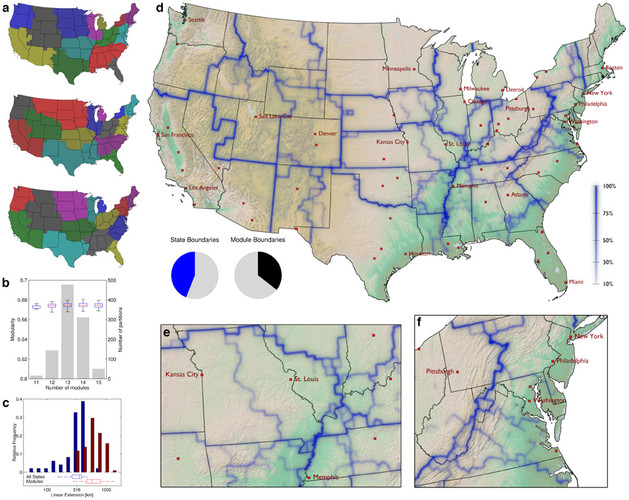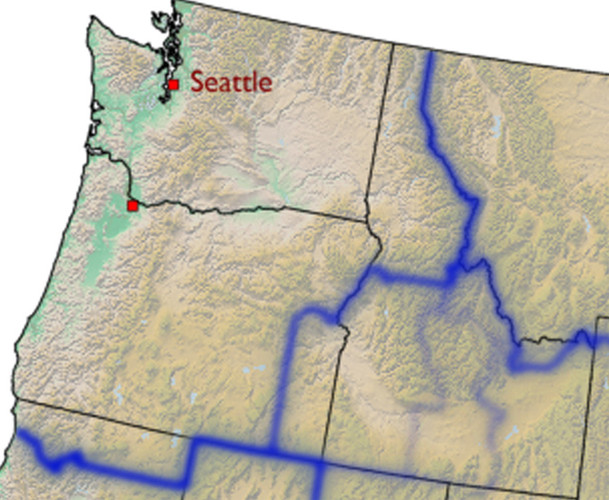In a recent article published on Facts CoExist theoretical physicist Dirk Brockmann argues that state boundaries are often arbitrary and out of date, no longer representative of how we communicate or function as a modern society. By tracking dollar bills he has created a series of maps redrawing state borders by how our money moves, which more accurately portrays distinctive areas based on regional economy.
When mapped in this fashion, Cascadia once again emerges, clearly delineated along a bioregional line.
Analyzing data from millions of single dollars, using information provided by the WheresGeorge.com project, Brockmann determined that state boundaries no longer correlate with how we move or communicate with each other. WheresGeorge.com is a grassroots money tracking group in which users enter zip codes and serial numbers of dollar bills, stamping each one so that when other users find it, it can be relogged. Each time this happens, users receive a hit, the top ‘Georger’ at the moment being an ammunition dealer who has logged more than two million bills, with roughly 500,000 hits.
Brockmann took the data for how the dollar bills traveled, and used network theory to draw lines where dollar bills are less likely to cross. The resulting map shows how "effective communities" don’t necessarily follow state lines.
This research continues to build on a wide range of data visualizations that support the idea of Cascadia as socially, linguistically, economically, environmentally and politically distinct from surrounding regions. The work builds on research released in December by MIT Senseable Cities Lab who working with AT&T defined regions based on who people communicate with, through social media and via telephone.
 The result findings are also very similar to what the federal policy and planning organization America 2050 has argued, defining roughly 11 megaregions in the United States. America 2050 is Regional Plan Association’s national infrastructure planning and policy program, providing leadership on a broad range of transportation, sustainability, and economic-development issues impacting America’s growth in the 21st century. Investigating these social interactions reveals interesting patterns for how people utilize space, and more than that, interact not only within that space, but with society at large, between neighborhood, city, county, state and region, defining what community really means in 21st century America.
The result findings are also very similar to what the federal policy and planning organization America 2050 has argued, defining roughly 11 megaregions in the United States. America 2050 is Regional Plan Association’s national infrastructure planning and policy program, providing leadership on a broad range of transportation, sustainability, and economic-development issues impacting America’s growth in the 21st century. Investigating these social interactions reveals interesting patterns for how people utilize space, and more than that, interact not only within that space, but with society at large, between neighborhood, city, county, state and region, defining what community really means in 21st century America.
In this newly regional model, cities play an important role, helping to pull nearby counties into their radius of influence, create commuting patterns, influence economic and environmental landscapes, and when they overlap, combine to create a new form of spatial geography and interaction known in the Pacific Northwest as the Cascadia Megaregion, defined as an area where “boundaries begin to blur, creating a new scale of geography”. These areas have interlocking economic systems, shared natural resources and ecosystems, and common transportation systems link these population centers together. In the Pacific Northwest, the Cascadia megaregion contains 17% of Cascadian land mass, but more than 80% of the Cascadian population.
These arguments also help to strengthen the idea that while we here in the Pacific Northwest are a part of very large countries, the United States and Canada, we still possess distinct cultural elements – language, literature, affiliations, communications – and an awareness of ourselves as members of a community which extends throughout our region, rendering many traditional boundaries obsolete and irrelevant.



